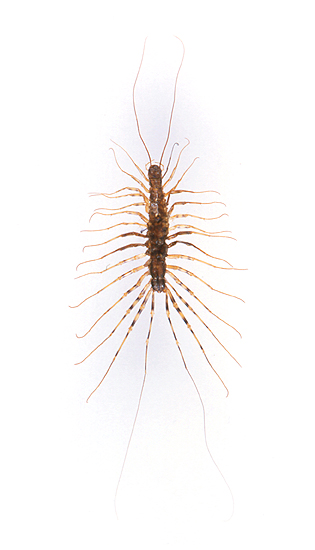House Centipede (Scutigera coleoptrata)
Pricing: No Specimens Available For Sale
Geographic Range: Europe & U.S.A.
View: Top
The house centipede Scutigera coleoptrata is perhaps best known by the name "thousand-legger". It is the bugbear of many apartment and house-dwellers who are not used to arthropods. The name "thousand-legger" is actually a name based on illusion, an illusion born of the speed at which house centipedes move and the speed at which people tend to run from them. They are frequently found inside buildings, usually in areas associated with moisture, where they will prey on small arthropods and make themselves useful by consuming insect pests. Actually quite harmless (we swear!), they are very delicate arthropods and their legs easily break off. They have 15 pairs of these legs, which grow longer toward the posterior end of the body (the last pair is as long as the antennae). Unlike other centipedes, they have a round head with large, compound eyes and dorsal spiracles. Scutigera coleoptrata is colored yellowish-brown, with three dark, longitudinal stripes. Probably indigenous to the Mediterranean, it has spread throughout much of Europe, Asia, and North America. Introduced at some point in Mexico, it spread north into the U.S.A., reaching Pennsylvania in 1849, New York in 1885, and Massachusetts in about 1890. These centipedes are easy to keep in captivity. Although not aggressive, the jaws of full-grown adults are powerful enough to pierce human skin and they will sometimes bite in self-defense when handled. Its venom is mild and will not have much effect on an adult unless delivered in a large dose by a very large specimen. Even then the pain is very mild and results in only minor, localized swelling around the bite punctures (unless there is an allergic reaction).

